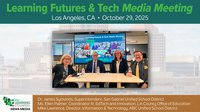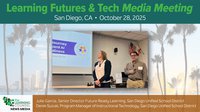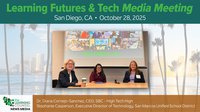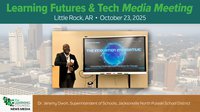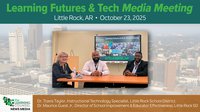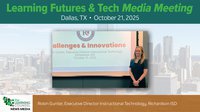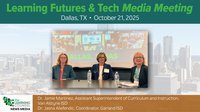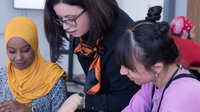As technology continues to evolve, more and more EdTech tools enter the marketplace. The use of these tools in classrooms has grown just as rapidly, with school districts employing an average of 2,591 different education technology tools. EdTech tools can lead to new learning opportunities and access to education for a wide range of learners, but using too many tools can also cause tech overload for both teachers and students. Learning and implementing new technology effectively takes time and training. Different tools meet the needs of different students, so there is a balance to be found between student engagement and teacher efficiency when determining which tools should be included in a district’s tech stack.
Leveraging EdTech for Effective Teaching
Selecting effective EdTech tools starts with aligning the tools with curriculum goals. Adoption of the tool should integrate into existing teacher workflows, enhancing the practices they already have in place. It should be easy to use, allowing teachers to quickly understand its functionality and how to implement it meaningfully. EdTech tools should also support accessible and inclusive learning experiences for all students.
High-quality education technology platforms, such as Lumio, can streamline the way educators design and deliver lessons. These platforms allow teachers to create engaging, adaptable and effective lesson plans quickly and easily.
Moreover, Lumio’s features facilitate multimodal learning experiences. With the ability to incorporate multimedia elements such as audio clips, videos, text, images and interactive stickers, teachers support learning for all students. Students have a range of options in how they showcase their learning, including attaching audio, using manipulatives, or including various multimedia elements. Additionally, Lumio provides opportunities for self-paced learning, empowering all students to choose when and how they learn.
Insights into Student Engagement
Having timely insights into students’ understanding and misunderstanding of the concepts being taught is essential to effective teaching. With platforms like Lumio, teachers can gain a top-line view of student responses across different activities, allowing them to check for understanding and provide timely feedback to their students. This data-driven approach enhances the ability to intervene early, helping teachers provide support and additional practice exactly when students need them.
Engaged learners are successful learners. A recent Gallup poll indicates that engaged students are 2.5 times more likely to believe they perform well academically and 4.5 times more hopeful about their futures compared to their disengaged peers. This helps students develop a strong self-efficacy belief which helps them persist when faced with challenging tasks.
Game-based activities are great tools for enhancing student engagement. Games are interactive and often collaborative, promoting social engagement and peer learning. Students can also use games to practice concepts and get immediate feedback. These activities not only capture students' interest but also encourage collaboration, critical thinking, and problem-solving skills. Leveraging a platform with game-based activities like Lumio makes it easy for teachers to bring active learning into the classroom. When students are actively involved in their learning through gamification, they are more likely to take ownership of their education, leading to deeper understanding and retention of concepts.
Moreover, the immediate feedback provided in game-based environments helps students recognize their strengths and areas for improvement, fostering a growth mindset. As educators leverage these dynamic tools, they cultivate an inclusive atmosphere where all students feel motivated to participate, thereby enriching the educational landscape and setting the stage for lifelong learning.
Successfully Implementing EdTech
EdTech tools can sometimes feel like one more thing added to a teacher’s plate. Successful implementation starts with the selection of tools that support existing workflows and align with curriculum goals. Professional development that goes beyond an overview of product features and provides explicit instruction on how the tool can be implemented into current instructional practices helps ensure effective and sustained use. Providing professional development in small chunks allows teachers to master one element before moving on to the next. Quick train videos and in-product support provide teachers with the help they need in the moment they need it.
Lumio provides professional learning support that empowers educators to innovate with technology and inspires them to use it creatively to enhance student engagement and achievement. We provide research-based, interactive training that aligns with proven learning strategies, enabling educators to learn effectively. To foster professional growth, Lumio offers scaffolded learning experiences tailored to individual needs, promoting best instructional practices. Finally, Lumio has a supportive learning community where educators can practice, share, and reflect, encouraging collaboration with peers.
EdTech for the Future
Innovation demands that we continually strive to remove barriers to learning for all students. Thoughtful EdTech implementation allows educators to design lessons that are engaging and suited to the diverse needs of their students. Access to useful data allows teachers to support students when and where they need it, helping to build meaningful connections and create enriching learning experiences.
About the Author

Kris Astle, Education Strategist with SMART Technologies, is an experienced strategist with a demonstrated history of working in the global education landscape. She is skilled in the integration of educational technology, instructional design and strategic planning. Kris has a global understanding of trends, research-based best practices, educational needs and the facilitation of change in the education landscape. She started her career in the classroom, teaching first in Switzerland and then in the US. She has launched both IB and ESL programs in schools she has worked in. She is passionate about meeting both students and teachers where they are and helping them use technology.




